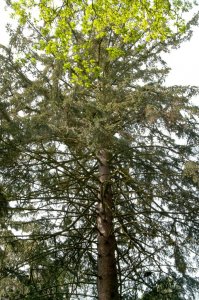
Norway Spruce (Picea abies)

| Occurrence in Děčín | It grows in many parks and forest parks. The oldest specimens can be found in forest parks (Kvádrberk and Pastýřská stěna). |
| Application |
In
both landscaping and landscaping it has a versatile use both for groups and
solitaire. For rapid growth it can be used as a filling wood into groups of
target trees (firs, Douglas firs etc.). It is well cut and therefore can be
used in hedges and walls. It has a plethora of cultivars ranging from dwarf to columnar and overhanging forms. |
| Habitat | Occurs naturally in the mountains with humid climates. That is why it is not very dry habitats. |
| Location |
Occurs
in northern and central Europe, extends southwards to the Pyrenees, Alps and
Carpathians, to the east to Russia. It rises to 2000m in the Alps. |
| Wood |
It has
soft but good quality so it is used in furniture; because of its excellent
resonance properties, old tree wood is used to produce top panels of top
musical instruments (violins, viol, voiloncel, double basses, mandolins and
guitars). |
| Fruits |
|
| Blossom |
Male
are beautifully purple, 20-25mm long, female cones grow at the end of last
year's shoots are purple-red, 4-5.5cm long. |
| Leaves |
Needles: are
10-20 (25) mm long, and 1mm thick, slowly pointed at the end, or sometimes
tapered, square, sometimes slightly squeezed, dark green, and usually shiny,
rarely bluish frosted, on all four sides 1-3 (4) faint lines of stomata. On the
underside of the branches are usually ridged. |
| Branches | Young shoots of brown to red-yellow, glabrous or gently pubescent, mostly shiny. Buds narrowly conical, pointed, light brown or reddish brown, with scales sessile, pointed, non-pollinating. |
| Rind |
|
| Treetop | 30-50 (50) m tall tree with crown pointed conical, branches horizontal, usually bent downwards, with trunk up to 1.5 (-3) m thick. |
| Note |
The largest specimen
of our district is the "Royal Spruce", which grows near Dolský mlýn
(290cm); The so-called "Great Spruce", which grew in the Křinice
Valley between Zadné Jetřichovice and Zadní Doubice on the German river bank
(over 310cm, h. 46m), was much more substantial until last year. The largest
specimen of the species in the Czech Republic used to be the so-called
"King of Spruce" at Boubín, which grew at an altitude of 1000 meters,
was 440 years old, obv. 508cm, and 57.6m high. Unfortunately, he died in 1969,
his successor, who was standing nearby, took a place in the city, but he also
died in 2004. "Těptínský spruce", which grew near Kamenice near
Prague, also seemed to be respectable. (band 515cm, v.58m, age 200let) *, but
also in 2008 fell. Among the largest living individuals we can count the
growing on the shore of Oslava near Březník in the district. Třebíč (c. 442cm),
"J. Chad-Ševětínský spruce" growing in the Lysice Game Reserve
(432cm), the so-called Wilhelm Spruces in Ruprechtov in the district. Vyškov
(420, 393, and 344cm), in Březina near Křtiny (418cm), and in the meadow above
Priessnitz Sanatorium in Jeseník - spa (407cm). According to monumental
trees.com, the most massive spruce in the world is a specimen growing in the
Biogradska Gora National Park in Montenegro (band 671cm, v.56.2m).
* data are not
verifiable from reliable sources, VÚKOZ Průhonice presents considerably more
modest dimensions |





